Curling of tomato leaves is a common problem when growing crops in greenhouses. In open ground, such a nuisance is less common.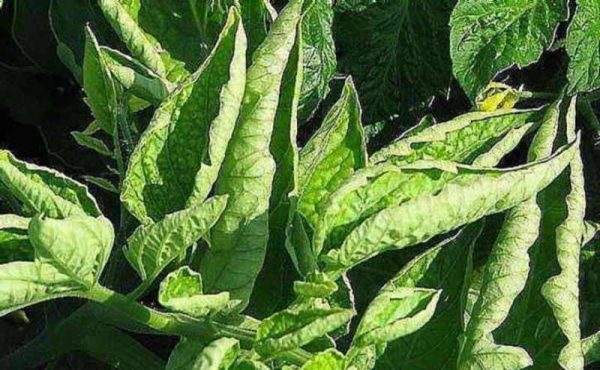
Causes of leaf curling
The main reasons are violation of agricultural technology.
- It's too hot in the greenhouse.
- Tomatoes lack moisture.
- Lack of batteries.
- Excess fertilizer.
- Damage to roots when planting seedlings or subsequent care of tomatoes.
- Untimely removal of stepchildren. Leaves also curl when too many shoots are removed at once.
- Pests sometimes also cause tomato leaves to curl.
- Features of the variety.
Depending on the reason, the leaves curl either upward in a boat or downward in the shape of a chicken's foot.
reason 1. Temperature
In a greenhouse, the temperature is always at least 5-7°C higher than outside, even if the doors and windows are open. Therefore, when the temperature in the greenhouse is above 27-28° and there is low air circulation, the leaves are curled into a tube to avoid excessive evaporation of moisture. At night, when the heat subsides, they straighten out again.
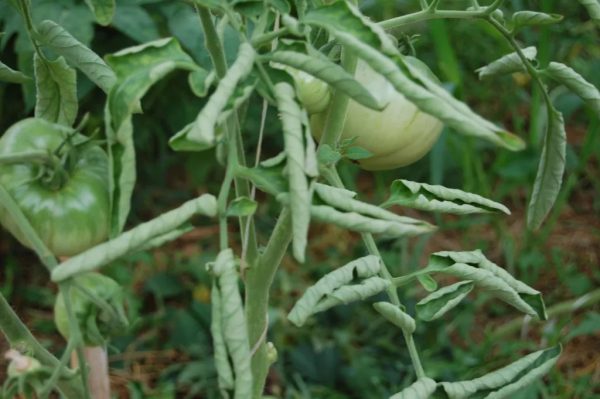
Very often the leaves curl due to high temperatures.
What to do
To prevent leaves from curling in hot weather, greenhouses are left open at night. To reduce the temperature, the greenhouse is shaded. There should be constant air circulation inside it. Even in cold weather it must be ventilated.
reason 2. Lack of moisture
With insufficient watering, especially in the heat (and in greenhouses these factors are inextricably linked), tomatoes also reduce the area of evaporation due to curling of the leaves.
It is usually recommended to water tomatoes once a week. But you need to be guided by the situation: if tomatoes grow on heavy clay soils, then watering is carried out even less frequently, but if on sandy soils, then once every 3-4 days.
- It is recommended to water tomatoes in greenhouses at a temperature of 16-20°C once every 7-10 days.
- At a temperature of 20-25°C once every 5 days
- At a temperature of 25-30°C every other day
- Over 30°C - daily, but very moderately.
This applies only to greenhouse plants; this watering regime is not suitable for open ground, since tomatoes there are additionally watered with precipitation.When choosing a watering regime, you should always take into account the growing conditions on your site.
If the leaves of tomatoes are curled, then the first thing to do is ventilate the greenhouse and water the crop.
You should not immediately water the plants abundantly. It is better to water in small volumes over several days. It is especially necessary to observe this regime during the fruiting period.
reason 3. Lack of batteries
If neither watering nor ventilation helped, and the leaves remain curled, then the problem is more serious than expected: the plants not enough batteries. Leaves curl differently depending on which element is deficient.
Phosphorus deficiency
The leaves curl upward and turn purple on the underside. Phosphorus is a macronutrient, and tomatoes consume it in large quantities.
To replenish phosphorus deficiency, the crop is watered with an extract of superphosphate. To prepare it, pour 1 cup of fertilizer into 1 liter of boiling water (otherwise it will not dissolve) and leave for 12-18 hours, stirring regularly. The finished extract is diluted with water to 10 liters and watered at the roots of the tomatoes. The application rate is 0.5 liters per bush.
You can add ash or superphosphate in dry form, but then you will have to wait 7-10 days longer for the effect.
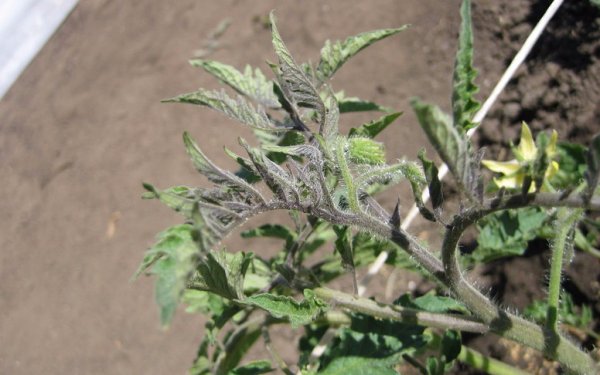
Tomatoes need to be fed with phosphorus.
Copper deficiency
A deficiency of the element is much less common (especially when tomatoes are treated with copper-containing drugs for diseases), but its deficiency is not as rare as one might assume. With a lack of copper, the edges of the leaves curl upward. Yellow blurry spots appear on the leaves, which turn black in case of acute deficiency.
There are many spots and they are located randomly over the entire leaf surface.The leaf appears healthy but yellow and curled. To eliminate the problem, tomatoes are sprayed with any preparations containing copper. You can water the bushes with the same solution.
Both spraying and watering not only replenish the microelement deficiency, but also protect tomatoes well from many diseases.
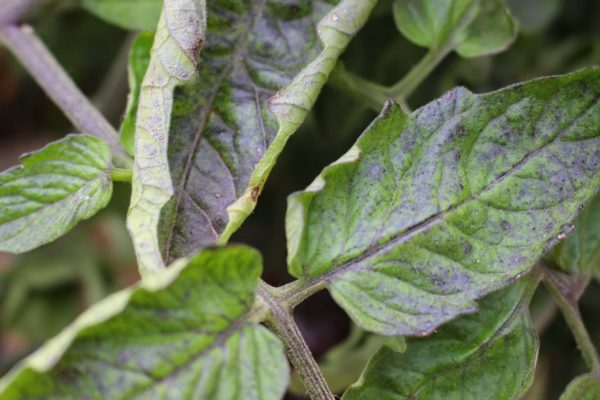
Feeding with microelements is required.
Potassium deficiency
The leaves curl up into a tube, and a brown border forms along the edges. Tomatoes consume slightly less potassium than phosphorus, so it is advisable to add it with each feeding. In case of severe deficiency, the bushes are fed with any chlorine-free potassium fertilizer.
The best for tomatoes is potassium nitrate, which also contains a small amount of nitrogen. 1 tbsp. l. fertilizers are diluted in 10 liters of water. Watering rate is 0.5 liters per bush.
An excellent fertilizer would be an extract from ash: 100 g of ash is poured with boiling water and left for 24 hours, stirring regularly. Then the solution is filtered and watered at the roots of the tomatoes. The consumption rate is 0.5 l per bush. If spraying is carried out with ash infusion, then 40 g of laundry soap is added to the working solution as an adhesive.
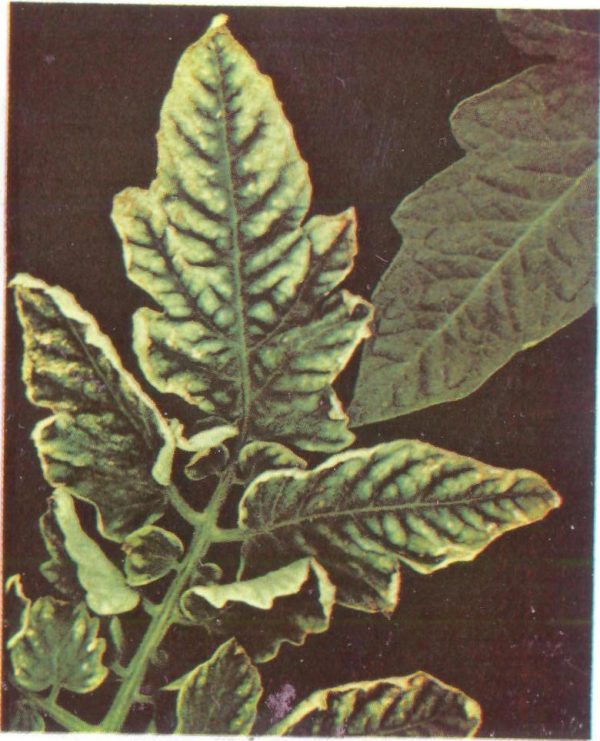
Such bushes require potassium fertilizing.
Nitrogen deficiency
Usually occurs on poor soils and with gross violations in agricultural cultivation techniques. With a lack of nitrogen, the leaves become yellowish and become smaller. As nitrogen starvation increases, the leaves begin to curl down, turn yellow and dry out.
Urgent feeding with any nitrogen mineral fertilizer is necessary. If it is not there, then the tomatoes are fed with manure or herbal infusion. 0.5 liters of infusion are diluted in 10 liters of water and fed to the plants. The application rate is 1 liter per bush.
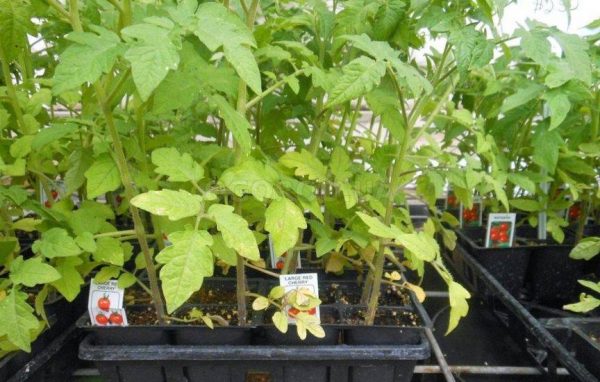
Pale leaves on tomatoes are due to a lack of nitrogen.
Calcium deficiency
The leaves curl upward. A little earlier, blossom end rot appears on the fruit. Feed the tomatoes with calcium nitrate: 10 g/10 l of water.
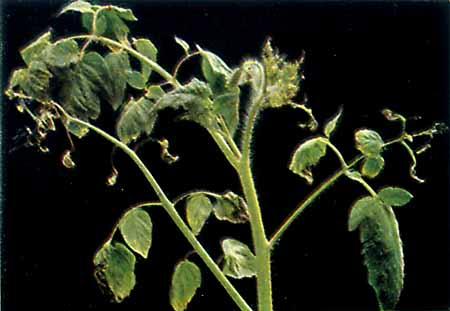
And here calcium supplementation is required.
reason 4. Excess fertilizer
Some summer residents, trying to get the maximum yield, apply so much fertilizer (especially organic matter) to their tomatoes that the plants begin to suffer from their excess, and this, in turn, very quickly leads to disease.
Excess nitrogen
The leaves at the top of the bush curl, the rest are very powerful and normal in appearance. To neutralize excess nitrogen, stop all organic fertilizing. An extract of wood ash or any potassium fertilizer that does not contain chlorine is applied under the bushes.
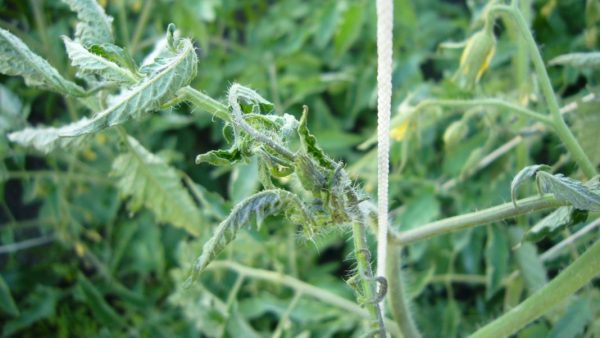
Excess nitrogen can also be harmful.
Excess zinc
It does not occur so often, but most summer residents cannot recognize it and only aggravate the situation. This happens when the multiplicity and frequency of microfertilizer application is violated. The leaves curl up and droop as if in drought.
The main sign of excess zinc is the appearance of a purple tint on the lower part of the stem (no higher than 20-30 cm). To correct the situation, tomatoes are fed with organic matter and no microelements are added for at least 15-20 days.
Some varieties have a genetically determined purple hue. But then the stem is evenly painted in this color.

Excess zinc is difficult to recognize.
reason 5. Damage to the root system
After planting seedlings, especially in a greenhouse, tomato leaves may curl slightly. This is fine. The root system of seedlings is usually less developed than the above-ground part, so for several days after planting, the leaves of the plants may be curled.If after 5-7 days they have not acquired a normal appearance, it is necessary to water the tomatoes with stimulants Kornevin or Heteroauxin.
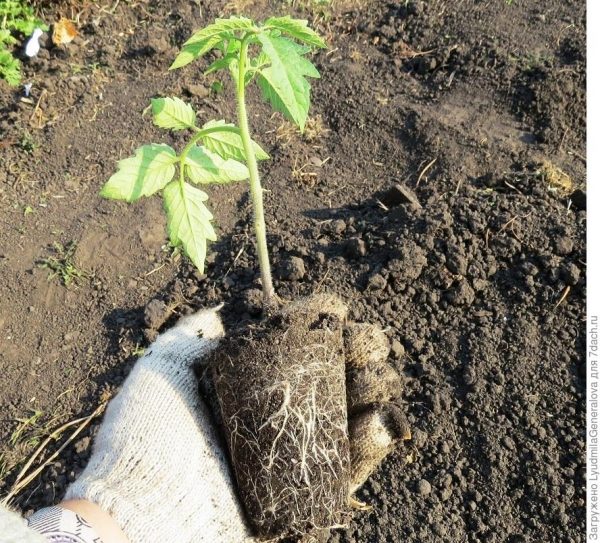
When planting seedlings in the ground, try not to damage the roots of the plants.
Roots are often damaged when deep loosening tomatoes. The leaves curl upward evenly throughout the bush. Neighboring plants look healthy. To correct the situation, water the tomatoes with root formation stimulants (Kornerost, Kornevin) and substances that support plant immunity: Epin-extra, Zircon.
reason 6. Incorrect stepsoning
Untimely removal of stepsons leads to leaf curling. Stepchildren are removed when their size is no more than 5-7 cm. If they have already outgrown, then it is too painful for the plant, so you will either have to leave them or remove them gradually over several days.
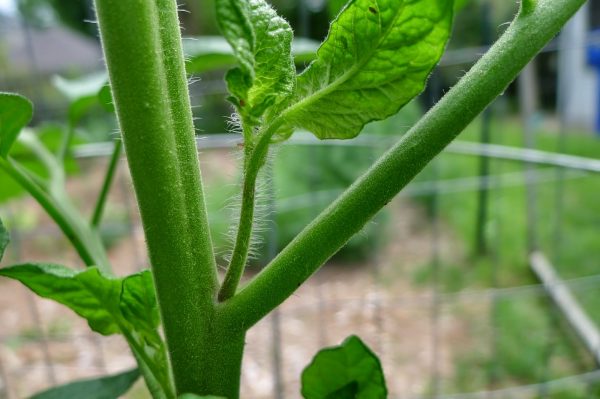
Removing overgrown shoots can affect tomato leaves.
If large stepsons have been removed and the tomatoes react to this by curling the leaves, then the only thing that can be done is to spray the tomatoes with Zircon or Epin-extra.
reason 7. Tomato pests
Greenhouse whitefly very often affects tomatoes in greenhouses. This is a small butterfly that lays eggs on the underside of leaves. Larvae and adults (butterflies) feed on plant juices. Insects secrete sweet honeydew, on which sooty fungus settles. The insect reproduces very quickly. It settles first on the youngest and most tender leaves at the tops of plants.
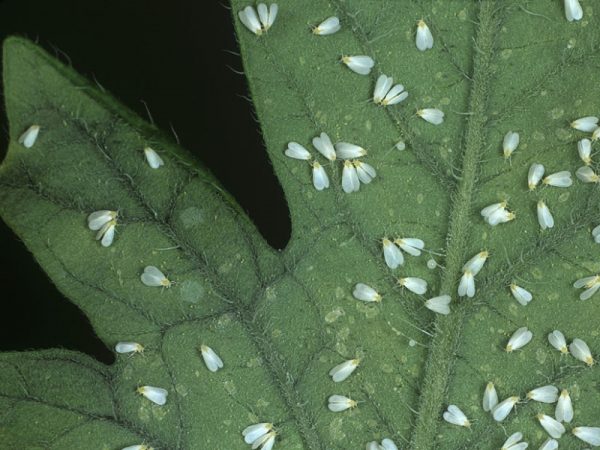
Avoid large concentrations of pests on tomato bushes.
Signs of defeat.
- The leaves become deformed and curled, and then turn yellow and fall off.
- On the underside you can find insect secretions in the form of sticky honeydew and small white scales - the remains of cocoons.
- Lagging bushes in development.
- The appearance of black spots of sooty fungus on the stems and leaves.
What to do
Once the whitefly spreads, it is very difficult to control it. The pest reproduces extremely quickly, and most insecticides have no effect on eggs and older larvae. Therefore, emergency measures must be taken when the pest is first detected.
When shaking bushes infected with whiteflies, the butterflies fly up and are easy to spot.
- To catch butterflies, glue traps are used, which are placed on the tops of bushes.
- When the pest spread is small, Fitoverm is used. Spraying is carried out on the underside of the leaves. This is a biological product and tomatoes can be removed 2 days after processing. Spraying is carried out repeatedly at intervals of 3-5 days to destroy newly emerged individuals, since the drug does not affect eggs. With strict adherence to treatment intervals, the number of pests can be significantly reduced.
- Simultaneously with Fitoverm, tomatoes are sprayed with Fitosporin or Alirin-B to prevent and destroy sooty fungi.
- In case of mass infestation of tomatoes by the pest, all fruits are removed in the technical ripeness phase, and the bushes are treated with Aktara. Treatments are carried out on the underside of the leaves at least 3-4 times with an interval of 4-7 days. After spraying, tomatoes should not be eaten for 20 days.
reason 8. Features of the variety
Some varieties of tomatoes Leaf curl is a genetic trait. Cherry and small-fruited tomato varieties are mainly prone to this.
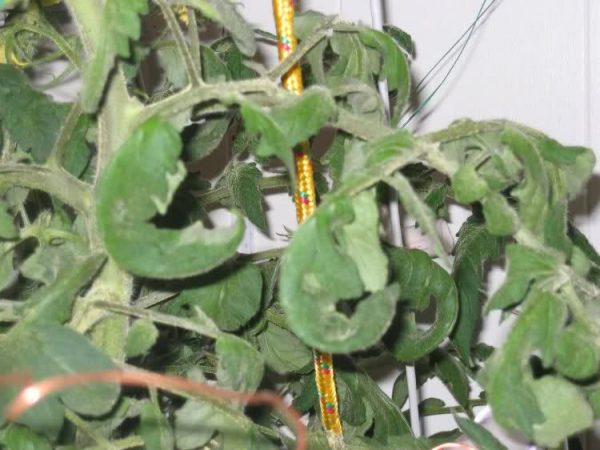
There are also tomatoes like this.
Usually in this case the leaf blade curls down, forming a “chicken's foot”. But in some varieties the leaves can curl upward. In this case, nothing needs to be done; neither fertilizing, nor watering, nor ventilation will help. This is simply a feature of the variety.
Conclusion
If the leaves on the tomatoes are curled en masse throughout the greenhouse, then this is either a violation of the temperature regime or a lack of moisture.
If the leaves curl only on some bushes, then most likely this is a lack of nutrients. In this case, they curl gradually, first on one plant, then on the second, third, etc.
First of all, these bushes are carefully inspected, and then one of them is fertilized with the necessary fertilizers. If the measures taken have produced results, then the remaining plants are fed. If there is no result, then they continue to select the necessary fertilizer until a positive answer is received. Only after receiving a positive reaction to fertilizing, all other tomatoes are fed with the same fertilizer.
It is not recommended to immediately feed all bushes with curled leaves, otherwise you can do a lot of harm.
If no measures help, the plants are healthy, there are no pests on them, they bloom and bear fruit, then it is better to leave them alone. Apparently, this is a feature of this plant; nothing can be done to help it.
Continuation of the topic:
- The most dangerous tomato diseases and methods of treating them
- Diseases of tomato seedlings, prevention and treatment of diseases
- What causes bell peppers and how to treat them
Watch the video:

 (14 ratings, average: 4,36 out of 5)
(14 ratings, average: 4,36 out of 5) CUCUMBERS NEVER GET SICK, I'VE BEEN USING ONLY THIS FOR 40 YEARS! I SHARE A SECRET WITH YOU, CUCUMBERS ARE LIKE THE PICTURE!
CUCUMBERS NEVER GET SICK, I'VE BEEN USING ONLY THIS FOR 40 YEARS! I SHARE A SECRET WITH YOU, CUCUMBERS ARE LIKE THE PICTURE! You can dig a bucket of potatoes from each bush. Do you think these are fairy tales? Watch the video
You can dig a bucket of potatoes from each bush. Do you think these are fairy tales? Watch the video
 How our fellow gardeners work in Korea. There is a lot to learn and just fun to watch.
How our fellow gardeners work in Korea. There is a lot to learn and just fun to watch. Eye trainer. The author claims that with daily viewing, vision is restored. They don't charge money for views.
Eye trainer. The author claims that with daily viewing, vision is restored. They don't charge money for views. A 3-ingredient cake recipe in 30 minutes is better than Napoleon. Simple and very tasty.
A 3-ingredient cake recipe in 30 minutes is better than Napoleon. Simple and very tasty. Therapeutic exercises for cervical osteochondrosis. A complete set of exercises.
Therapeutic exercises for cervical osteochondrosis. A complete set of exercises. Which indoor plants match your zodiac sign?
Which indoor plants match your zodiac sign? What about them? Excursion to German dachas.
What about them? Excursion to German dachas.